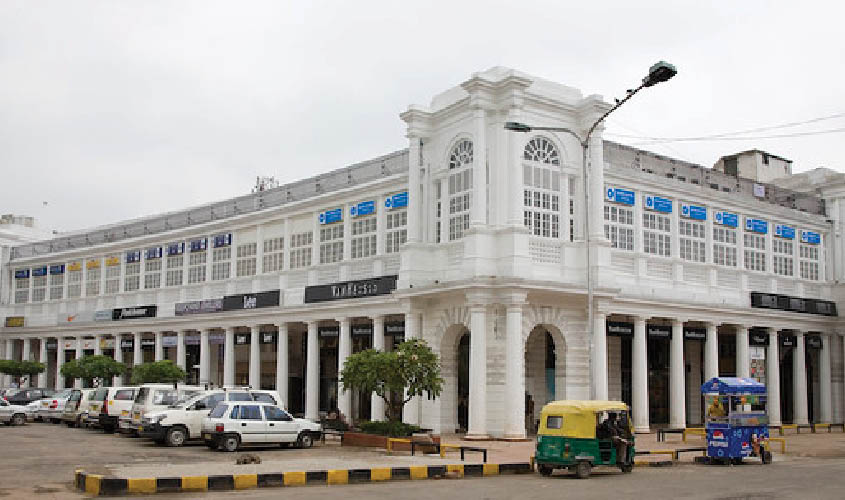A hare-brained scheme of pedestrianising Connaught Place appears to be the latest obsession of the Indian bureaucracy. The New Delhi Municipal Council (NDMC), which in the past has also attempted to transform the basic landscape of India’s most well-known commercial establishment, is now bent upon regulating vehicular traffic entering the Inner Circle. The result being that Connaught Place would lose its traditional clientele and the traders would be up in arms against a move which sounds totally impractical.
Three days back the NDMC had informed the traders of a proposal which had been cleared by the Delhi traffic police and would lead to this switchover and complete makeover. The New Delhi Traders’ Association general secretary, Vikram Badhwar, claims that the document that has been sent to them was both confusing and misleading; it does not take into account the discussions held with the authorities over a period of time. It is an imposition of an idea which is not workable, given that while pedestrianisation may work in Western countries on account of cooler climate, the replication of this model would be counterproductive, especially because being a tropical country, Delhi has an eight month long summer in various shades. No wonder, the British had made Simla as the Summer Capital from April to October.
The unique selling point of Connaught Place, which has a circular anatomy to it, was that those desirous of shopping at any particular store could drive in and park their car at the designated parking area. If the entry of cars gets restricted or regulated in the inner circle, no one would like to visit their favourite shops since it would be extremely inconvenient.
The discussions that had taken place between bureaucrats and the representatives of the traders entailed allowing a single entry and exit point into the inner circle with the parking areas not being disturbed in any of the blocks. What this necessitated was that vehicles would enter CP through the radial road connecting the Janpath and go out from the radial road leading towards the Baba Kharak Singh Marg. This was also likely to result in chaos since at present, motorists can enter the inner circle from Janpath, the radial road near the Plaza cinema and the radial road leading towards the Embassy restaurant. The exit points are located on radial roads going towards the Barakhamba Road, the one connecting Baba Kharak Singh Marg, the Radial road opposite the Marina Hotel in the direction of Panchkuin Road and the one proceedings towards the outer circle from the Odeon cinema.
In fact, those familiar with CP would know that all the three circles have their pronounced character but the inner circle is the heart of the shopping complex. In any case ever since the Metro was introduced in Delhi, the nature of the clientele too, has undergone a sweeping change. Many of the shops which were synonymous with CP have shut down; these include SC Sharma and Sons, Snowhite, Janakidas and Sons, Amarsons, Kemp and Co and so on. Well known restaurants such as Gaylords, Standards and Volga are also relics of the past, except those who have grown up in the city, cherishing fond memories of them. Although, Embassy, United Coffee House and Yorks continue to flourish, a plethora of new bars, night clubs and eating joints have come into existence.
In short, CP has had its share of metamorphosis. There is no flagship Nirulas at the L Block corner with Haldiram taking its place. On the footpath, erstwhile book sellers are now engaged in more lucrative ventures of selling mobile phone accessories and many fly-by-night operators who enjoy the patronage of NDMC staff, obstruct the circular corridors and the paths that connect one block with the other. In fact, the logic given by some NDMC officials is that once motor vehicles are denied entry into the inner circle, there would be fluid movement. They refuse to address the problem of encroachments since it benefits the staff besides leading to, on a daily basis, massive monetary collections.
The matter of concern is: where would the vehicles be parked if there is total pedestrianisation? In this scorching heat, which would only get worse once humidity sets in, why would anyone come towards CP? It is one thing to window-dress Connaught Place, particularly when the government is ready to spend on smart city projects, but it is absolutely another matter if the pragmatic aspects of such a scheme are not taken into account.
Over a period of time, change is inevitable in all cities. The increase in footfalls, following the running of the Metro, has brought in certain elements into CP that were quintessentially identified with Chandni Chowk. The traffic police maybe theoretically on board regarding this plan, but would not choking vehicular movement in any part of New Delhi lead to problems elsewhere? During Parliament sessions, many demonstrators converge on Jantar Mantar, compelling the police to cordon off Parliament Street. The consequence being that there are cascading repercussions leading to snarls in many other roads connecting Connaught Place. Fortunately, the Union Urban Affairs Minister, Hardeep Singh Puri is a Delhiite having attended both school and college in the city. He, therefore, understands the importance of Connaught Place and its defined and clear-cut position. He has been a career diplomat as well having served in various countries; thus naturally he would ensure that the iconic Connaught Place is left as it is. Between us.

